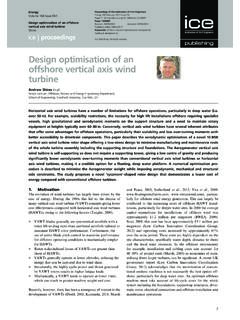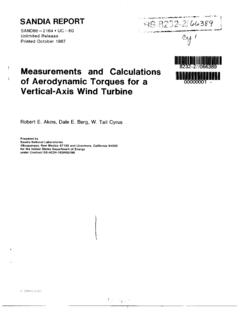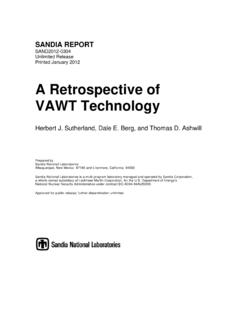Transcription of Vertical Axis Wind Turbine development - ULisboa
1 1 Vertical axis wind Turbine development Guilherme Silva Abstract: wind power is, nowadays, the most promising and suitable renewable energy for rapid and cost-effective implementation. Horizontal axis wind turbines have been greatly developed but some other technologies, such as the Vertical axis wind turbines are still in an initial development phase. The disparity in the development of these technologies remains unexplained. Nevertheless, the little development made in Vertical axis wind turbines seems to emphasize this technology as being one of great potential.
2 This present work aimed to create an analysis of this technology. Models were developed, and a wide range of CFD results were obtained using the kw SST model. In the end, a small wind Turbine intentionally built for this work was tested. Keywords: VAWT Darrieus Giromill H-rotor Vertical axis wind Turbine wind power Kw model. ABBREVIATIONS AND ACRONYMS A Area; AR Aspect ratio; c Blade chord; DC Drag coefficient; LC Lift coefficient; PC Power coefficient; COE Cost of energy; D Drag; EU European Union; f Frequency; F Force; nF Lateral force; tF Tangential force; HAWT Horizontal axis wind Turbine ; I Moment of inertia; L Lift; LC Lifetime costs; LEO Lifetime energy output; M Torque; n Number of blades; P Power; r Radius; Re Reynolds number; t Time; V Velocity; VAWT Vertical axis wind Turbine ; incutV_ Start-up velocity.
3 OutcutV_ Maximum velocity; iV Induced velocity; pV Blade s flow velocity; ratedV Nominal velocity; V wind velocity; Angle of attack; Angular position; Tip speed ratio; Density; Solidity; Angular velocity; Kinematic viscosity. I. INTRODUCTION wind energy is the energy from the wind . This form of energy can be converted to other more useful forms such as electricity, through the use of wind turbines. wind power is the power, in W, given by the kinetic energy of wind in a given area, per unit of time[3]: 321 AVPwind , (1) being is the density of air in kg/m3, A the area considered in m2 and V the wind velocity in m/s.
4 Worldwide, the use of wind power has been rising, around 25% per year, since the early 1990s. This increase has been stronger in Europe. In the future, this trend is expected to continue mainly through the use of offshore areas[5]. The efficiency of wind turbines is normally characterized by the power coefficient[3]: 321 AVPPPC turbinewindturbineP . (2) wind turbines can be divided into two types. In drag turbines, movement is produced by the air drag while in lift turbines movement is produced by the air lift in the Turbine s blades.
5 One of the most important concepts of wind turbines is the tip speed ratio defined as Vr , (3) being r the blade s velocity in m/s and V the wind velocity in m/s[1]. 2 In drag turbines, theoretically, 1 . Drag turbines also tend to start movement at lower V but have high drag at high V. On the other hand, lift turbines have starting problems, usually needing help to start but have lower drag at high V and usually superior PC[1]. wind turbines can also be divided into HAWT (Horizontal axis wind Turbine ) and VAWT ( Vertical axis wind Turbine ).
6 VAWTs seem to have easier maintenance, less noise and do not need alignment with the wind [1,3]. Many types of wind turbines have been developed as shown in Figure 1. Figure 1 Types of wind turbines The most widely spread type of wind Turbine is the 3-bladed HAWT, but other types have demonstrated good feasibility, such as the Darrieus or the giromill Turbine . The giromill Turbine , using untwisted straight blades allows an easier construction and transport, reducing costs[1]. The Betz s limit is the theoretical maximum PC value: %592716max PC (4) calculated assuming an ideal Turbine , with infinite number of blades, without losses [3].
7 II. WORKING PARAMETERS Although giromill VAWTs are the simplest type of wind Turbine , its aerodynamic analysis is very complex[1]. Consider a Turbine with radius r, spinning at angular velocity within a flow with velocity V. The blade s wind velocity pV can be decomposed into its normal component nV (pointing from inside to outside the Turbine ) and its tangential component tV (pointing from the leading edge to the trailing edge): )cos( VrVt, (5) )( senVVn . (6) With the increase of , tV becomes the dominant component in pV, diminishing the blade s angle of attack [8]: tnVV1tan.
8 (7) Replacing in the previous formulas, )cos()(tan1sen. (8) Graph 1 according to and is independent of V and it varies less with increase. For 3 , 20max . pV is given by[8]: 22ntpVVV . (9) Combining the previous formulas: 1cos22 VVp, (10) 12 VVp, (11) The mean Reynolds number can be obtained by cV 1Re2 . (12) being c the blade s chord in m and the kinematic viscosity of air in m2/s. For a VAWT with 10 ccm, with 8 and 11 Vm/s, 5106Re . The resulting aerodynamic forces in the blades can be obtained by the interpolation of LC and DC according to the airfoil used and the given conditions of and Re.
9 This kind of information is hard to find for typical working conditions of a VAWT (low Re and high )[2]. The blade s force components can be obtained by[8]: cosDLsenFt , (13) DsenLFn cos, (14) as depicted in Figure 2. -90-75-60-45-30-150153045607590090180270 360 1234567 3 Figure 2 VAWT s aerodynamic forces It can be concluded that has a primary importance in the intensity of tF. As seen before, depends on . This relationship defines the working conditions of the Turbine . At low , is high, making the blade stall, diminishing the DL ratio.
10 At high , is low and the tangential component of L is small. There is an optimum where is high enough for the tangential component of L to be considerable and low enough for the DL ratio to be high. For a VAWT, optimum is usually between 3 and 5[1]. According to these conclusions, an airfoil suitable for a giromill VAWT should stall at high , allowing its use at high (low ), maximizing the tangential component of L, increasing tF. On the other hand, the DL ratio should be kept high to reduce the drag on each blade.



















